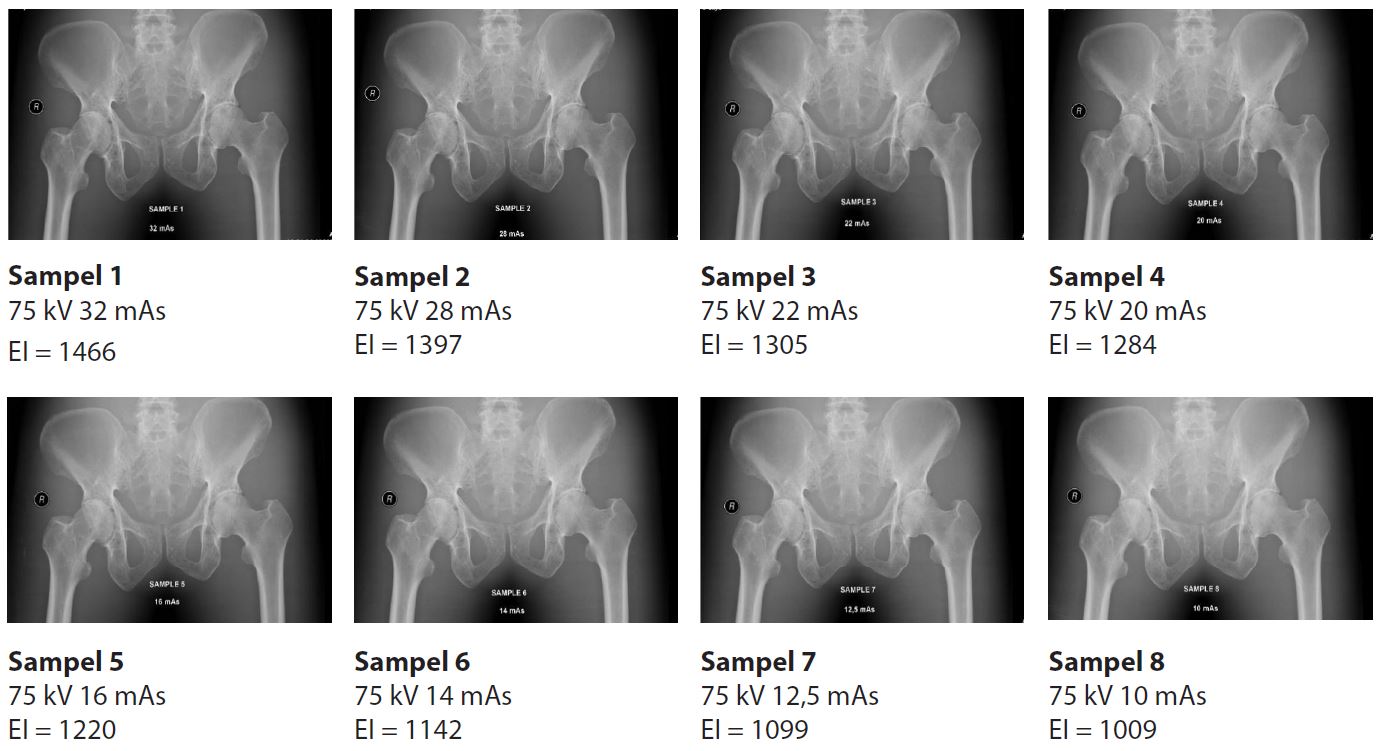DOSE OPTIMIZATION WITH mAs REDUCTION OF 15% USING COMPUTED RADIOGRAPHY ON RADIOGRAPHIC EXAMINATIONS PELVIC AP PROJECTION

Downloads
Background: Routine pelvic radiograph examination commonly performed in diagnostic radiology services is a pelvic examination of anteroposterior projection (AP). This results in direct exposure to ionizing radiation to the internal organs in the lower abdomen, especially the reproductive organs. Purpose: Optimizing the dosage of AP projection pelvic radiographs. Method: Research is conducted quantitatively and used experimental approach with an analysis of 15% mAs reduction from the standard mAs value on AP projection pelvic examination on radiation dose and image quality using anthropomorphic phantoms. The radiation dose analysis uses the exposure index indicator. In contrast, the image quality uses the Visual Grading Analysis method, then it was continued with the Kappa Cohens test to determine the level of agreement between 2 respondents. Result: The exposure factor with the mAs value reduced by 15% from the standard exposure factor on the AP projection pelvic radiography affected the decrease in the value exposure index. The EI value generated from the optimization exposure factor shows a decrease to 300 EI, which means the dose produced is only half of the standard exposure factor dose but still produces an acceptable image, as evidenced by the VGA score. As an assessment of image quality. In this study, there was no significant difference with range VGA scores 1,7. Besides that, the test had the Kappa Cohens level of agreement with a value of 0.5-0.8. Conclusion: All images resulting from the 15% mAs value reduction variation can be used as a diagnostic assessment.
Ambasari, T., Santoso, B., Apriantoro, N.H., Anita, F., 2014. Analisis Optimasi Citra Radiografi pada Pemeriksaan Thorax Sistem Computed Radiography (CR) terhadap Entrance Surface Dose (ESD). J. Ilm. Giga Univ. Nas. Vol.17 (1), Pp. 1-8.
Badan Pengawas Tenaga Nuklir (BAPETEN), 2019. Pedoman Tingkat Panduan Diagnostik atau Diagnostic Reference Level (DRL).
Bath, M., Hakansson, M., Hansson, J., Mansson, L.G., 2005. A Conceptual Optimisation Strategy for Radiography in A Digital Environment. Radiation Protection Dosimetry. Radiat. Prot. Dosimetry Vol.114(1-3), Pp. 230-235.
Bontrager, K.L., Lampignano, J.P., 2017. Textbook of Positioning and Related Anatomy, 8th ed. ed. Elsevier Canada, China.
Busch, H.P., 2000. Need for New Optimisation Strategies in CR and Direct Digital Radiography. Radiat. Prot. Dosimetry Vol.90(1-2), Pp. 31-33.
Bushong, S.C., 2013. Radiologic Science for Technologists: Physics, Biology, and Protection, 10th ed. ed. Elsevier.
Butler, M.L., Rainford, L.A., Last, J., Brennan, P.C., 2009. Optimization of Exposure Index Values for The Anteroposterior Pelvis and Antero-posterior Knee Examination. Proc. SPIE - Int. Soc. Opt. Eng. 7263 Pp. 726302-1-726302-8.
C.T.P.Chan, K.K.L.Fung, 2015. Dose Optimization in PelvicRadiography by Air Gap Method on CR and DR Systems - A Phantom Study. Radiography Vol.21(3), Pp. 214-223.
Compagnone, G., Pagan, L., Baleni, M.C., Calzolaio, F.L., Barozzi, L., Bergamini, C., 2008. Patient Dosein Digital Projection Radiography. Radiat. Prot.Dosimetry Vol.129(1-3), Pp. 135-137.
Davies, A.M., Pettersson, H., 2012. The WHO Manual of Diagnostic Imaging: Radiographic Anatomy and Interpretation of The Musculoskeletal System. World Health Organization.
Decoster, R., Mol, H., Broeck, R. van den, Smits, D., 2013. Assessment of Image Quality in Orthopaedic Radiography with Digital Detectors: A Visual Grading Analysis. In: Decoster, R. (Ed.), Proceedings of SPIE - The International Society for Optical Engineering 8673. Florida, US.
Federle, M.P., Cohen, H.A., Rosenwein, M.F., Brant-Zawadzki, M.N., Cann, C.E., 1985. Pelvimetry by digital radiography. Clin. Radiol. 36, 327–330.
Irsal, M., 2020. Evaluasi Faktor Eksposi dalam Upaya Optimisasi pada Pemeriksaan Radiografi Chest PA Suspected COVID - 19. In: Adnin, R. (Ed.), KOCENIN Serial Konferensi. Kocenin, Jakarta, Vol.1(1), Pp. 1.11.1-1.11.10
Irsal, M., Hidayanto, E., Arifin, Z., 2014. Analisa Pengaruh Faktor Eksposi Terhadap Entrace Surface Air Kerma ( ESAK ). Youngster Phys. J. Vol.3(4), Pp. 271-278.
J.Mount, 2016. Reject Analysis: A Comparison ofRadiographer and Radiologist Perceptions of Image Quality. Radiography Vol.22(2), Pp. e112-e117.
Karoussou-Schreiner, A., 2005. Dose Optimisation In Computed Radiography. Radiat. Prot. Dosimetry Vol.117(1-3), Pp. 139-142.
Lanca, L., Silva, A., 2009. Digital Radiography Detectors -A Technical Overview: Part 2. RadiographyVol.15(2), Pp. 134-138.
Long, B.W., Rollins, J.H., Smith, B.J., 2019. Merrill's Pocket Guide To Radiography, 17 th. ed. Elseiver.
Ludewig, E., Richter, A., Frame, M., 2010. Diagnostic Imaging – Evaluating Image Quality using Visual Grading Characteristic (VGC) Analysis. Vet. Res. Commun. Vol.34(5), Pp. 473-479.
Metaxas, V.I., Messaris, G.A., Lekatou, A.N.., Petsas, Theodore G. Panayiotakis, G.S., 2019. Patient Dose in Digital Radiography Utilising BMI Classification. Radiat. Prot. Dosimetry 184(2), Pp. 155–167.
Mraity, H.A.A.B., England, A., Hogg, P., 2017. Gonad Dose in AP Pelvis Radiography: Impact of Anode Heel Orientation. Radiography Vol.23(1), Pp. 14-18.
Seeram, E., 2019. Digital Radiography Physical Principle and Quality Control, 2 nd. ed. Springer, Singapore.
Seeram, E., Davidson, R., Bushong, S., Swan, H., 2016. Optimizing the Exposure Indicator as A Dose Management Strategy in Computed Radiography. Radioloogic Technol. Vol.87(4), Pp. 380-391.
Smith, W.L., Farrell, T.A., 2014. Radiology 101: The Basics and Fundamentals of Imaging, 4 th. ed. Wolters Kluwer, Philadelphia.
Uffmann, M., Schaefer-Prokop, C., 2009. Digital Radiography: The Balance between Image Quality and Required Radiation Dose. Eur. J. Radiol. Vol.72(2), Pp. 202–208.
Zheng, X., 2017. Patient Size Based Guiding Equations for Automatic mAs and kVp Selections in General Medical X-Ray Projection Radiography. Radiat. Prot. Dosimetry. Vol.174(4), Pp. 545–550.
Copyright (c) 2022 Journal of Vocational Health Studies

This work is licensed under a Creative Commons Attribution-NonCommercial-ShareAlike 4.0 International License.
- The authors agree to transfer the transfer copyright of the article to the Journal of Vocational Health Studies (JVHS) effective if and when the paper is accepted for publication.
- Legal formal aspect of journal publication accessibility refers to Creative Commons Attribution-NonCommercial-ShareAlike (CC BY-NC-SA), implies that publication can be used for non-commercial purposes in its original form.
- Every publications (printed/electronic) are open access for educational purposes, research, and library. Other that the aims mentioned above, editorial board is not responsible for copyright violation.
Journal of Vocational Health Studies is licensed under a Creative Commons Attribution-NonCommercial-ShareAlike 4.0 International License














































